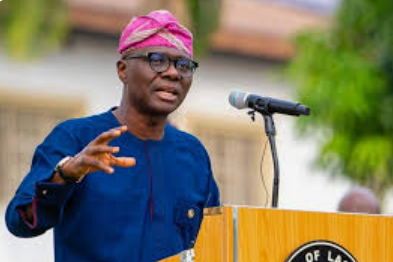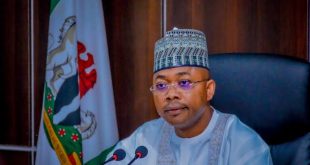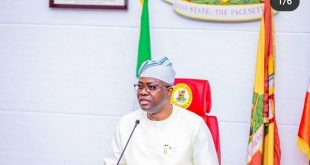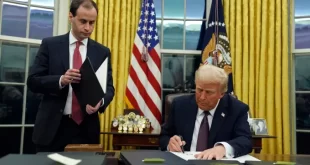Lagos State Governor, Babajide Sanwo-Olu, discusses the state’s debt profile, the delay in the 4th Mainland Bridge project, the construction of an alternative airport, and other key issues in an interview with Seun Okinbaloye on Channels TV’s Politics Today programme.
In terms of nightlife, Lagos was ranked higher than Miami and Dubai. How does this make you feel?
It is something that we have been working on for a while now. We know that for a massive city like this, it comes with a whole lot of responsibility. The city has to be alive and work almost 24/7. It must be a place where people can commune, do business, and have a work-life balance. It should be a city where people can move from one part of the city to another without any hindrance. So, the good news is that it is not just the nightlife but also the daylight. More importantly, people must feel safe at night. They must feel that they can go to different parts of the city and be safe before, during, and after their visit, and they should be able to return home safely. For us, that is not just a celebration, but it tells us that some of our efforts have been recognized. However, this also means we need to do more. The easy part is getting it done, but the difficult part is sustaining it and making sure we continue to remain relevant. We need to continue opening up avenues where both international and local visitors can feel safe, conduct business, and enjoy the city at night. More importantly, we need to ensure that the economy of Lagos — which is the biggest in Africa — continues to grow. A 12-hour economy will never do justice to a big city like this. In major cities, the economy has to function close to 24 hours, with a minimum of 18 hours. So, the nightlife of Lagos is part of its economy, and it’s one of the factors that will make Lagos not only a resilient city but a livable city. It will make it comparable to other mega cities around the world. So yes, we appreciate the recognition, but for us, it means we must continue to push forward, raise the bar, and ensure that all our first responders are up to the task. They should be able to respond to emergencies at any time of the night, with the police, fire service, and emergency teams all working effectively. We must have doctors on standby at hospitals. These are the things that make a city work, and these are the things that are equally important for the nightlife of any city Yes, we take it as a compliment, but what it tells me is that we need to continue doing what we are doing and continue to do it well.
If you mention the biggest cities of the world — Miami, Dubai, Paris, London — there are unique things about these cities. What is your dream identity for Lagos?
The dream identity would be a Lagos that truly works for everyone. A Lagos where you can have predictable journey times. You should be able to come out of your house or office and safely say that in 30 or 35 minutes, plus or minus five minutes, you can get to a predictable destination. A Lagos that encourages all the creative minds it has. A Lagos where the strength lies in its people, the social life, and the creative world. It’s a city where creativity is fostered and you are constantly driven to push your limits. A Lagos where safety and security are paramount, where you are always alive to your responsibility. A Lagos where the financial sector and financial transactions continue to bloom and grow. A Lagos where businesses — small, medium, and large corporations — see it as home, a place where their staff are safe and their businesses thrive. It’s a Lagos where government continues to provide an enabling environment for businesses to succeed. These are the visions I have: to make Lagos a truly resilient and workable city for everyone. There are challenges, particularly around the population explosion, but that’s something we can discuss later. Ultimately, I want a Lagos that has an effective, efficient public transportation system, one that is reliable and safe. A Lagos where the nightlife, the creative industries, the fashion, and the food are thriving, and where they are unique to the environment. That is the Lagos we want to see. We often say, “Eko o gba gbere”, and it’s real. If you come to Lagos, if you’re hardworking, you will do well, and you will reap the benefits of Lagos. It’s a place where you can truly pick money off the street. The population is ripe with intelligence, knowledge, and the ability to think and innovate — these are the things that make Lagos stand out. When you compare it to cities like Miami and Dubai, you need to consider size and population. The whole of the UAE has about five million people, which is fewer than four or five local governments in Lagos. So, in terms of size and demography, Lagos should be compared to New York, Los Angeles, Bombay, and New Delhi. When you consider those parameters, Lagos has earned its place as a mega city with the status it deserves. In Lagos, no matter what energy you have, Lagos can help you project that energy positively. It will help you realize your dreams, whether in the creative industry, entertainment, fashion, or business. Small and medium enterprises will find a home here. Everything needs to work, and work well. Our responsibility as government is to provide security, public transportation, functional healthcare facilities, and public schools where people have choices. These are the things government needs to focus on to ensure the city works. The rest is for the people to take charge and make things happen. Government is not meant to crowd businesses or hinder them. We are meant to be enablers — a government that opens its arms and helps its citizens realize their full potential. That is the Lagos we want to build and leave behind in two and a half years.
Let’s talk about traffic. The congestion is usually headaching, especially for people who live on the mainland but work on the island and have to spend hours in traffic. Can you give them some good news about what your government is planning to ease traffic congestion in Lagos?
First, we need to compare apples to apples. I took a trip to New York less than 18 months ago, and it took us 30 minutes to travel six blocks, less than a kilometer. That’s New York for you. Lagos has a similar demography, as does Bombay in India or Istanbul in Turkey. The number of vehicles on the road is a reflection of the economic value of the citizens. What is the government’s role? We need to intervene in what’s called mass urban transportation. In Lagos, we have developed a robust, integrated urban mass transportation system across rail, BRT buses, waterway transport, taxis, and large-mile buses. All of these make up the public transportation system people rely on. Take the rail system, for example. The red and blue lines are strategic in identifying key corridors where the population density is highest. The red line runs from Oyingbo in the south, all the way up to Agbado, in Ogun State — a nearly 29-kilometer rail corridor. The blue line runs from Marina westward towards Okokomaiko, and it is currently at Mile 2, with phase two reaching Okokomaiko. The green line, which we just signed the MOU for, will connect Lekki to the Epe axis. So, we are thinking of the western, eastern, and north-south parts of Lagos. These are the areas with the largest population. In addition, we have waterway transport options. We are developing transport corridors from Ibeshe in Ikorodu to Falomo, Badore, and others, including routes from Ojo in Oriade to Liverpool, and from Liverpool to Marina.
But road transportation still causes significant congestion. The pressure on the three main bridges connecting the mainland to the island — Third Mainland, Kara, and Eko Bridges — is a result of limited options. People still don’t fully understand that there are alternatives.
Part of what we’re doing is to address where the pressure is coming from. For instance, the Red Line connects Agbado, Iju, Agege, Ikeja, Oshodi, Mushin, Yaba, and eventually Ebutemeta. This rail corridor will resolve many road transportation issues. A journey that once took two and a half hours can now be done in under one hour. Yesterday, for example, it took us just 36 minutes from Ebutemeta to Ikeja. It’s going to be an additional seven to nine minutes to Agbado. This is a game-changer for us. But if you look at some of the cities you mentioned, in New York, for example, or in the heart of London, the tubes and all the other forms of transportation are being used effectively. What figures do you have in terms of the effectiveness of these transportation alternatives? I think it is about time you leave Abuja and come to Lagos. Let’s go on this famous ride, and you will be able to see it. I mentioned Agbado; I didn’t mention Victoria Island, Lekki, or Ikorodu. But Agbado—that’s where my people are. Agbado, Iju. That’s where the vulnerable segments of the population are. That’s where they reside: Agege, Mushin, Oshodi.
What is the cost of the transportation, Governor, given the current economic realities?
It is differential pricing; it’s not a fixed price. For example, if you board at Ebute-Meta, by the time you’ve made three to four stops, the total price is about N800 to N850. But if you take the whole journey to the end, to Agbado, it’s N1,500. If you compare that with a train in the UK, as you mentioned, and you make six stops, you’ll realize that the cheapest fare would be six pounds. Six pounds today, given the exchange rate, is what? Almost N10,000. Let’s not even do the conversion—it will be far out of range. So let’s leave that aside, because N1,500 is about a dollar; N1,500 is less than a pound. But we should keep in mind that there are two different economies. I don’t want to mix Naira and dollars because that’s not how I was trained. But the reality is to consider the GDP of our people, their earning capacity, and reflect on what we need to do to help them. So it is N1,500 from Ebute-Meta to Agbado. It will cross a minimum of 10 local governments. If you need to take an alternative route, there is clearly no way you will spend anything less than N2,000 or N2,500. But even at that, the plan is for us to start this and conduct tests. Once we are able to guarantee our minimum threshold, it will be possible for me, a month from today, to bring it down by another 15 to 20%. You will remember that when we started the Blue Line, which started with about N800 from Marina to Mile 2, I brought it down by about 20-25%. Today, we have carried close to three million people on that rail corridor. So a similar thing will happen with this line. But this one is a longer route and has more stations. In terms of affordability, this is critical for us. It’s for the vulnerable, for the lower-income groups, and also for the middle and upper classes. Train services, like everywhere in the world, also give people the option to drop their cars and ride the train because it’s faster and more convenient. They don’t want to sit in traffic. They don’t want to hold on to their steering wheels for an hour. So, it’s for everyone. And on the Red Line, for example, there’s also space to carry some luggage. In terms of affordability, you can test it. I am a people’s governor and a people’s person. If you think, or if you feel that the numbers are way out of line, I will be the first person to readjust them. But based on the indices we have seen, we believe it reflects a fair market.”
Tell us about the Green Line and Purple Line.
The Green Line is a line that will run along the eastern part of Lagos. It will travel all the way from Marina, through Lekki, and continue towards the refinery on the Lekki-Epe Expressway. Fortunately, we signed an MOU with MUFI (Ministry of Finance Incorporated) and CHEC, a Chinese consortium, and we are working with them. We have since returned from China and have started conversations. We have done due diligence in terms of feasibility and viability studies. So, it’s really up to MUFI to sit with us and design the model for the infrastructure, and we’re ready to go. The Purple Line, incidentally, we are also planning to sign a deal sometime before the end of the year, in November or December. They are extremely interested in this project and are planning to bring together a group of funders for us. The Purple Line is supposed to run from Iba Junction all the way to Mowe. This line will criss-cross through all of Alimoso and extend to the end of Ojudu, continuing all the way to Mowe. So, you can see that we have plans for everyone. I think there is also a Yellow Line that goes towards Ikorodu. Every part of Lagos, under the six integrated rail transit systems, must touch all five divisions of Lagos in one critical form or another. So, we have the Green Line deal on the table, which we plan to sign an MOU for. We are also planning for the Purple Line before the end of the year. We hope to secure investors who will also be able to sign on. Once that is done, we’ll be ready to break ground and start construction. You also mentioned the minimum wage and what I need to do for my people. I am glad to let you know that the minimum wage for Lagos, which we have discussed with our unions, is N85,000 today. It’s not a competition, so I am not going to say that we are paying more than others. It’s a function of affordability and capacity. But we know very well that living in Lagos comes with a premium in terms of the cost of living. We are fully aware of this. We actually increased our salary earlier in the year, and rightly so, for our staff. I will continue to do that. I would like to come back to you in January and say that I have been able to increase the minimum wage in Lagos to N100,000—not because I want to make anyone look bad, but because I want my people to have a living wage. I want them to truly know that the government is working for them. We will cut unnecessary expenses and ensure that the benefits we offer are meaningful, so they don’t just get dropped off at the bus stop but are truly taken home. That’s the kind of plan we have for them. And you also know that right now, we are implementing differentiated working hours for our civil servants and public workers in Lagos State.”
These two infrastructure projects—the Fourth Mainland Bridge and the alternative airport, which we assume will be around the Lekki axis—what is delaying these projects? Any updates?
It’s money.
I will give you some if you don’t mind.
Well, we don’t mind. It’s just that yours won’t take us very far; you are not a very wealthy investor. But let me explain. What have we done? We have structured these transactions to make them attractive. We’ve designed these models to make them investor-friendly, and we’ve done everything related to the Fourth Mainland Bridge. I also need to thank Mr. President, especially with the alternative on the Lagos-Calabar Highway, which will run parallel from Ahmadu and follow the Atlantic Ocean towards the Free Trade Zone. So, we have the Lekki-Epe Expressway in the middle, right? The plan is to have what we call a lagoon highway on the farthest parts of the Lekki Peninsula, which will also run towards Epe. The Fourth Mainland Bridge is supposed to run from Ajah and cross over to Ibeshe in Ikorodu. We’ve done extensive work—everything has been concluded: the alignment, the hydrographic study, the viability study, the feasibility studies, and everything is on the table. It’s just about showing me the money. And you see, for me, we have to live responsibly. We know what the financial constraints are. We’ve had concessionaires who we’ve sat with. Unfortunately, I must say this: the kind of requests they are asking of us, we cannot grant. They are asking for a sovereign guarantee. I am a sub-national; I am not a sovereign. So, it’s a difficult call. I cannot just walk to the Honourable Minister of Finance and say, “Give me a sovereign guarantee.” It doesn’t work like that. It has to be negotiated. It has to be something they can also carry in their budget. So, it’s a fairly long conversation to get to that point. We’re looking for other ways to proceed with this. As for the airport, that’s a more straightforward investment decision. We want to have our skin in the game. We’re planning to raise investment, but we also need to work with the federal government. We have meetings planned with FAN, the NCAA, and the Federal Ministry of Aviation. We have approval, but it’s more than just approval.
Lagos stands as the highest debtor, whether foreign or local, among the federating units. With all these projects you are already mentioning. There are those who feel that Lagos is already in huge debt, and yet you’re talking about this funding.
Let us use the proper term when you say “huge debt.” There is a difference between huge debt and affordable debt. You have to look at your funding structure and your ability to pay. Let me give you a simple example: Why did it take us so long to complete the Blue Line, and why did we start the Red Line and complete it in less than three years? It’s the audacity and the power of “you can do it.” If, after COVID in 2020, we didn’t take the leap of faith to say that we wanted to do it, today, if we had tried to start any of those infrastructures, not only would they be four times the price, but we would never be able to do it. If you miss a chance yesterday, today is your next best chance. If you leave it and don’t do it, then you won’t have any opportunity to do it. We have a strong conviction in our minds, we know our people deserve it, and we know we’re doing the right thing. In terms of debt, Lagos’ ability to carry this burden is not reckless.”
 National Telescope national telescope newspaper
National Telescope national telescope newspaper



